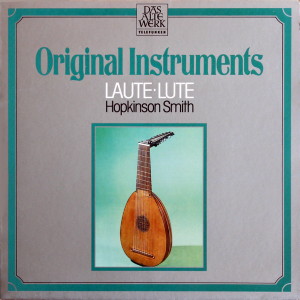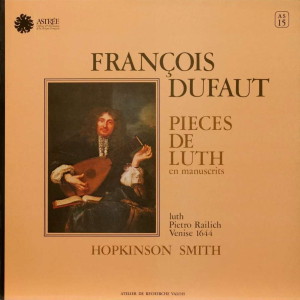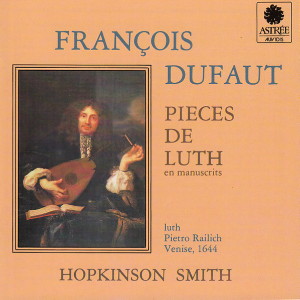 |
1 LP -
Telefunken 6.42328 AP (p) 1977
|
 |
| 1 LP -
Astrée AS 15 (p) 1977 |
 |
| 1 CD -
Astrée E 7735 (c) 1989/1990 |
|
| ORIGINALINSTRUMENTE - Laute |
|
|
|
|
|
|
|
| François Du Fault
(17. Jh.) |
Suite
e-moll |
|
11' 05" |
|
| Pieces
de luth en manuscrits |
-
Prélude |
1' 05" |
|
A1 |
|
-
Allemande |
3' 55" |
|
A2 |
|
-
Courent |
1' 58" |
|
A3 |
|
-
Sarabande |
2' 51" |
|
A4 |
|
-
Gigue |
1' 16" |
|
A5 |
|
Suite
g-moll |
|
11' 08" |
|
|
-
Tombeau de Mr. Blanrocher |
4' 15" |
|
A6 |
|
-
Courante |
1' 35" |
|
A7 |
|
-
Sarabande |
3' 46" |
|
A8 |
|
-
Gigue |
1' 32" |
|
A9 |
|
Suite
a-moll |
|
13' 16" |
|
|
-
Prélude |
1' 22" |
|
B1 |
|
-
Allemande |
3' 40" |
|
B2 |
|
-
Gigue |
1' 44" |
|
B3 |
|
-
Courante |
2' 00" |
|
B4 |
|
-
Courante |
1' 40" |
|
B5 |
|
-
Sarabande |
2' 50" |
|
B6 |
|
Suite
C-dur |
|
9' 33" |
|
|
-
Allemande |
3' 42" |
|
B7 |
|
-
Sarabande |
2' 22" |
|
B8 |
|
-
Gavotte |
1' 39" |
|
B9 |
|
-
Sauterelle |
1' 50" |
|
B10 |
|
Pavane
e-moll |
|
8' 55" |
B11 |
|
|
|
|
|
Hopkinson SMITH,
Laute (Pietro Railich, Venedig,
1644) - Leihgabe des Germanischen
Nationalmuseums, Nürnberg
|
|
|
|
|
|
Luogo
e data di registrazione |
|
Studio
du Domaine de Vernou,
Indre-et-Loire (Francia) -
novembre 1976 |
|
|
Registrazione:
live / studio |
|
studio |
|
|
Producer |
|
Michel
Bernstein |
|
|
Recording
Supervision
|
|
Dr.
Thomas Gallia, Milan |
|
|
Edizione LP |
|
TELEFUNKEN
- 6.42328 AP - (1 LP - durata 54'
00") - (p) 1977 - Analogico |
|
|
Originale LP
|
|
ASTRÉE
- AS 15 - (1 LP - durata 54' 00")
- (p) 1977 - Analogico |
|
|
Prima Edizione CD |
|
ASTRÉE - E 7735 -
(1 CD - durata 54' 00") - (c)
1989/1990 - AAD |
|
|
Note |
|
Produced
by Astrée |
|
|
|
|
When the
instrument used in
this recording
left the Venice
workshop of Pietro
Railich in the
year 1644, lute
making by German
craftsmen in Italy
had already seen a
tradition going
back some hundred
and fifty years.
Among the earliest
lute makers in
Italy of whom
there is
documentary
evidence are Laux,
Sigismund Maler
and Hans Frei, all
in Bologna, and
Marx Unverdorben
in Venice. Their
products were
highly esteemed bu
the nobility and
musicians of the
time and
established the
foundations of the
fame of Italian
lute construction.
Their
characteristic
elements are the
long frawn shape
of the body and
narrow neck,
usually
accomodating 6
courses (eleven
strings). Padua,
in addition to
Bologna and
Venice, became a
further centre for
lute making, and
it was here also
that some members
of the
Tieffenbrucker
settled down.
Probably the most
productive among
them was Wendelin
Tieffenbrucker,
who was active in
the period around
1600. Many
instruments from
his workshop can
still be found
today in museums
and private
collections.
Similarly, his
contemporary
Michael Hartung is
also regarded as
one of the best
lute makers of his
age. In the second
decade of the 17th
century Venice
became a lively
centre where a
large number of
German lute makers
worked, among them
Matteo and Giorgio
Sellas, Christoph
Hoch, Giovanni
Hieber, Martinus
Kaiser and Pietro
Railich. Many of
these instruments
are conspicuous
for the
particularly round
contours of the
body, recalling
pictures of lutes
of the 15th
century. Our
instrument from
Pietro Railich's
workshop is also
one of these.
The instrument,
beloging to the
Germanisches
Nationalmuseum, is
in addition to
some chitarroni
and guitars,
presumably the
onsly extant lute
from the workshop
of Pietro Railich.
It is signed as
follows: PIETRO
RAILICH ALLA GIOIA
VENETIA 1644.
The rear of the
body flattens out
considerably. 15
ribs made of
rosewood with
ivory inserts in
between form the
back. A rosette
with a geometrical
ornamentand floral
elements has been
carved in the
spruce belly. The
neck, made of a
soft wood, has a
rosewood and ivory
veneer on the
reserve side, like
the back of the
instrument, and
possesses 9 catgut
frets, which were
tuned to medium
pitch for this
recording. The
peg-box, arranged
at the rear just
like the back, has
20 pegs (that for
the cantino is
located in a
different
position).
The instrument has
11 courses, of
which the two
upper ones are
singly and the
others doubly
stringed. It is
tuned A - d - f -
a - d' - f' for
the six highest
courses, while
those beloware
adapted in
diatonic sequence
to the particular
key.
The American
lutenist Hopkinson
Smith, who now
lives in Basle, is
known for the fact
that does research
work into early
music and treats
the repertoire of
music of the
renaissance and
the baroque
periods in France,
Germany, England
and Spain with a
new musical
approach. As a
pupil of Emilio
Pujol and Eugen M.
Dombois, he worked
with Alfred
Deller, Desmond
Dupré and the
Studio of Early
Music. In 1972 he
acquired his music
diploma at Harvard
University and
then devoted
himself to
studying Latin
American music,
thanks to a
Harvard University
schilarship. In
the same year he
was awarded the
Erwin Bodky Prize
for his
interpretation of
early music.
Hopkinson Smith is
a member of the
Ensemble Hespérion
XX, he works at
the Schola
Cantorum
Basiliensis and
has a given
concert
performances
throughout
Switzerland,
Germany, France,
England, Italy,
Spain and
Yugoslavia.
(English
translation by
Frederick A.
Bishop)
|
|
|

